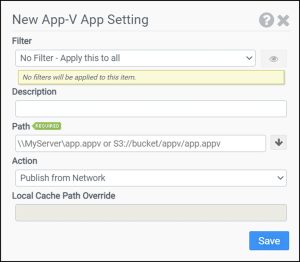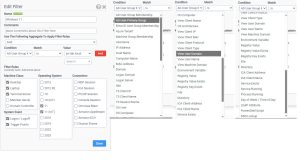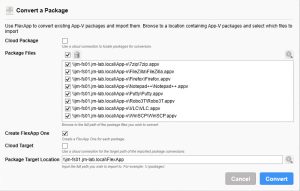Microsoft’s App-V management server/console is retiring in April 2026, while the App-V Client & Sequencer remain in fixed extended support (no new features). In short: you can keep running App-V packages, but you shouldn’t count on Microsoft’s management server after April 2026. Microsoft Learn
Good news: you don’t have to rush a big-bang migration. With Liquidware ProfileUnity and FlexApp, you can stabilize first managing existing App-V packages cleanly then modernize to FlexApp on your schedule.
Stabilize now: manage App-V packages with ProfileUnity (no PowerShell required)
ProfileUnity’s App-V Apps module delivers and maintains App-V packages directly from UNC or cloud paths, with local caching for fast launches. Actions include Publish from Network, Publish from Local Cache, and Remove (single or all). Liquidware Documentation
Why this matters: Unlike hand-rolled scripts, ProfileUnity performs App-V registration through the client service and UI workflows so you don’t have to enable or grant end-user PowerShell scripting just to manage App-V apps. (Microsoft’s native guidance for administering App-V centers on PowerShell; ProfileUnity replaces that need with policy-driven delivery.) Microsoft Learn
Add ProfileUnity’s context-aware targeting (filters by user/device/OU/OS, etc.) and resilient storage options (UNC and cloud) to keep App-V delivery precise and reliable while the Microsoft server components age out.
Modernize when ready: bulk-convert App-V ? FlexApp
When it’s time to move on, FlexApp offers mass conversion from App-V right in the FlexApp Packaging Console (including cloud-hosted packages). You can convert in batches, optionally create FlexApp One packages, and import directly to your target repository. Liquidware Documentation
Roadmap note: FlexApp’s isolation capability is planned for early 2026 to add an extra compatibility/containment layer for tricky apps. (Forward-looking statement.)
Bonus: FlexApp + Azure Virtual Desktop (AVD) App Attach
Running AVD? FlexApp integrates with App Attach so you can dynamically attach apps to sessions and shrink base images.
- Microsoft docs: App Attach overview (how it works and what it enables). Microsoft Learn
- Microsoft partner listing: Liquidware is an approved partner for App Attach, with links to FlexApp documentation and support. Microsoft Learn
- Liquidware blog announcement + demo: FlexApp integration with AVD App Attach. Liquidware Digital Workspace Management
Recommended path
- Now ? April 2026
Keep your existing App-V packages running under ProfileUnity. Use filters for precise scope, and local cache to improve performance while serving packages from UNC or cloud. - At your pace
Start a rolling conversion to FlexApp—high-change or high-ticket apps first; stable App-V packages can remain under ProfileUnity until convenient change windows. - Future-proof
Standardize on FlexApp for dynamic, cross-platform delivery (physical, VDI, DaaS, AVD/W365/Citrix/VMware). Layer in AVD App Attach where it makes sense, and adopt FlexApp isolation when it lands.
Microsoft lifecycle links to work into the post
- App-V in Windows: support policy (Client/Sequencer in fixed extended support; Server/Console ends April 2026). Microsoft Learn
- MDOP lifecycle announcement (standardized end-of-support date April 14, 2026 for App-V server components). Microsoft Learn
If you’re not ready to convert to FlexApp today, ProfileUnity can manage your App-V packages cleanly without enabling PowerShell scripting for users so you can convert gradually to FlexApp and tap AVD App Attach when and where you want.












Leave A Comment
You must be logged in to post a comment.